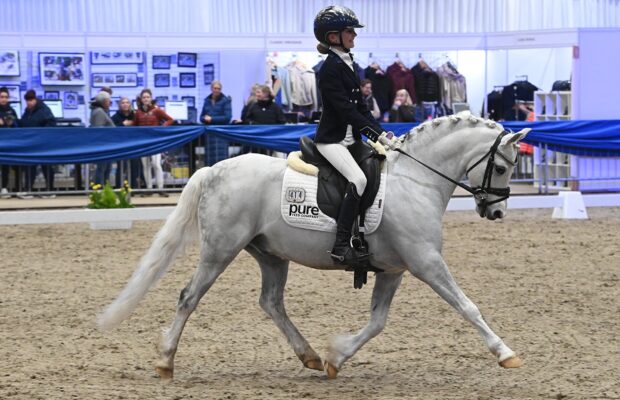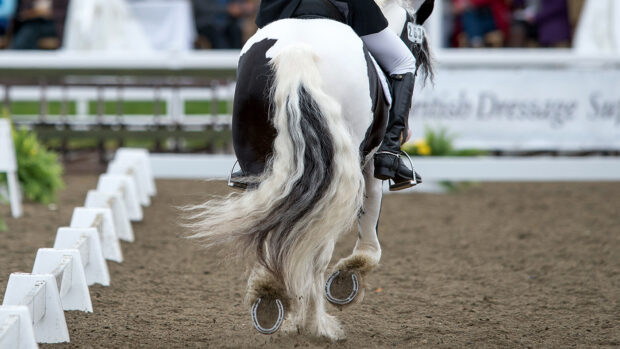When watching others ride, the 10-metre loop can look relatively straightforward. But when you’re in the saddle, you may find it feels more challenging than you expected.
Grand prix dressage rider Hannah Esberger-Hancock says: “There’s actually a lot going on with a 10m loop and practising before riding it in a dressage test is vital. The judges are looking to see a smooth change of bend and that your horse maintains balance, suppleness and rhythm throughout. The best evidence for this is that your horse remains on two tracks throughout the movement – no swinging quarters or falling through shoulders.”
So why should you include 10m loops in your schooling sessions? While they feature in plenty of dressage tests and lack of accuracy will lose you marks, 10m loops are also an excellent exercise for improving balance and suppleness, as well as introducing the horse to counter-canter.
How to ride a 10m loop
As with any new movement, visualising pulling the whole thing off can feel daunting — so let’s break it down into some practical steps you can follow in the saddle.
“Bear in mind the size of the arena you’re riding in,” adds Hannah, who holds seven national and 23 regional titles. “Everything happens much more quickly in a 20x40m arena and the line you ride to and from X is steep. In a 20x60m test, the curve you is much more gradual and it takes a bit longer than expected to reach X.”
1. Starting in a 20x40m arena in trot, begin by riding deep into the corner. Apply a half-halt on the short side to balance the trot, then push your horse into the corner with your inside leg, keeping your outside leg and contact secure.
2. While in the corner, look up and ahead to X, so you leave the track at the corner marker while maintaining activity and slight inside flexion.
“One of the biggest faults is too much inside bend, which causes a loss of straightness,” says Hannah. “It should be very slight flexion in the jowl. Instead of focusing on bend, think about keeping your horse’s neck in the middle of your body. This will help prevent curling and keep his body straight.”
3. Ride towards X — this is a steep angle in a 20x40m arena. Shortly after leaving the track, change your horse’s bend as the line you’re riding curves towards the centre line. Apply your new inside leg to push your horse into the new outside rein, keeping your new outside leg secure so he doesn’t drift.
4. The uppermost part of your loop should bisect the centreline at X. “It’s acceptable to hit the centreline just before X, but only marginally,” warns Hannah.
Immediately look for the next corner marker, and begin your return to the track by the mirroring the gradient of the first half of your curve. Be mindful of your rhythm and the pull of the outside track — your horse may drift through his shoulder to hurry back.
5. Just before you return to the corner marker, softly switch back to the original bend in preparation for the corner. Use the corner to rebalance and reestablish connection.
Once you are confident in trot, you may want to step up the exercise by performing the 10m loop in canter, bearing in mind things will be happening more quickly.
“When you’re riding a 10m loop in canter, where you would show a change of bend in trot you show counter-canter,” concludes Hannah. “The key is to keep your horse’s inside leg underneath his body and the weight off his outside shoulder. A good way to set this up is to maintain connection in the outside rein and ensure you use the outside aids to turn away from the wall, maintaining that security in the outside rein throughout.”
As with any dynamic schooling exercise, 10m loops can run your horse’s battery down. Aim for quality over quantity and give him plenty of breaks.
You might also be interested in…

H&H’s expert guide to counter canter: all you need to know

Master advanced movements with top tips from Gareth Hughes and Richard Davison

Subscribe to Horse & Hound magazine today – and enjoy unlimited website access all year round
Horse & Hound magazine, out every Thursday, is packed with all the latest news and reports, as well as interviews, specials, nostalgia, vet and training advice. Find how you can enjoy the magazine delivered to your door every week, plus options to upgrade your subscription to access our online service that brings you breaking news and reports as well as other benefits.




